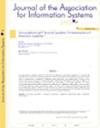Living in a Fishbowl or Not: The Role of Transparency and Privacy in Creative Dialogues on Enterprise Social Media
IF 5.5
3区 管理学
Q1 COMPUTER SCIENCE, INFORMATION SYSTEMS
引用次数: 0
Abstract
Transparency—the observability of activities, behaviors, and performance—is often treated as a panacea for modern management. Yet there is a conundrum in the literature, with some studies suggesting that transparency may benefit group creativity and others suggesting that privacy may do so. A similar conundrum exists regarding the effects of different social capital types—structural holes vs. network cohesion—on group creativity. Enterprise social media (ESM) provide a unique opportunity to solve these conundrums by allowing groups to be “transparent” (non-group members can observe and/or participate in group activities) or “private” (group members and activities are hidden from the community) and enabling groups to develop distinct social capital structures. Using data from 28,083 written interactions produced by 109 transparent and 106 private groups in an ESM of a multinational design firm, we found strong support for our contingency hypotheses that both transparent and private groups may produce high levels of creative dialogues, yet in different forms. Specifically, expansion-focused creative dialogues— those focused on combining or expanding existing concepts—emerge in transparent groups, but only when the group’s social capital is characterized by structural holes. Conversely, we found that reframingfocused dialogues—those focused on challenging and rethinking—emerge in private groups but only when the group’s social capital is characterized by network cohesion. Theoretically, these findings can help to solve the conundrums in the literature on group creativity and shed light on the role of ESM use in this context. Practically, our findings offer a critical reflection o contemporary initiatives for increasing transparency, whether through physical design or digital transformation.是否生活在鱼缸里:透明度和隐私在企业社交媒体创造性对话中的作用
透明度——活动、行为和绩效的可观察性——通常被视为现代管理的灵丹妙药。然而,在文献中有一个难题,一些研究表明,透明度可能有利于群体创造力,而另一些研究表明,隐私可能会这样做。关于不同社会资本类型(结构漏洞vs.网络凝聚力)对群体创造力的影响,也存在类似的难题。企业社交媒体(ESM)提供了一个独特的机会来解决这些问题,它允许群体“透明”(非群体成员可以观察和/或参与群体活动)或“私人”(群体成员和活动对社区隐藏),并使群体能够发展独特的社会资本结构。利用一家跨国设计公司的ESM中109个透明团体和106个私人团体产生的28,083份书面互动的数据,我们发现有力地支持了我们的偶然性假设,即透明团体和私人团体都可能产生高水平的创造性对话,但形式不同。具体来说,专注于扩展的创造性对话——那些专注于结合或扩展现有概念的对话——出现在透明的群体中,但只有当群体的社会资本以结构漏洞为特征时才会出现。相反,我们发现,专注于挑战和重新思考的重构对话出现在私人群体中,但只有当群体的社会资本以网络凝聚力为特征时才会出现。从理论上讲,这些发现有助于解决文献中关于群体创造力的难题,并阐明在这种情况下使用ESM的作用。实际上,我们的研究结果为当代提高透明度的举措提供了批判性的反思,无论是通过物理设计还是数字化转型。
本文章由计算机程序翻译,如有差异,请以英文原文为准。
求助全文
约1分钟内获得全文
求助全文
来源期刊

Journal of the Association for Information Systems
工程技术-计算机:信息系统
CiteScore
11.20
自引率
5.20%
发文量
33
审稿时长
>12 weeks
期刊介绍:
The Journal of the Association for Information Systems (JAIS), the flagship journal of the Association for Information Systems, publishes the highest quality scholarship in the field of information systems. It is inclusive in topics, level and unit of analysis, theory, method and philosophical and research approach, reflecting all aspects of Information Systems globally. The Journal promotes innovative, interesting and rigorously developed conceptual and empirical contributions and encourages theory based multi- or inter-disciplinary research.
 求助内容:
求助内容: 应助结果提醒方式:
应助结果提醒方式:


